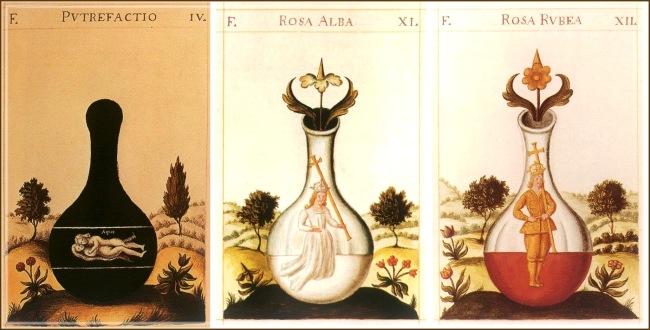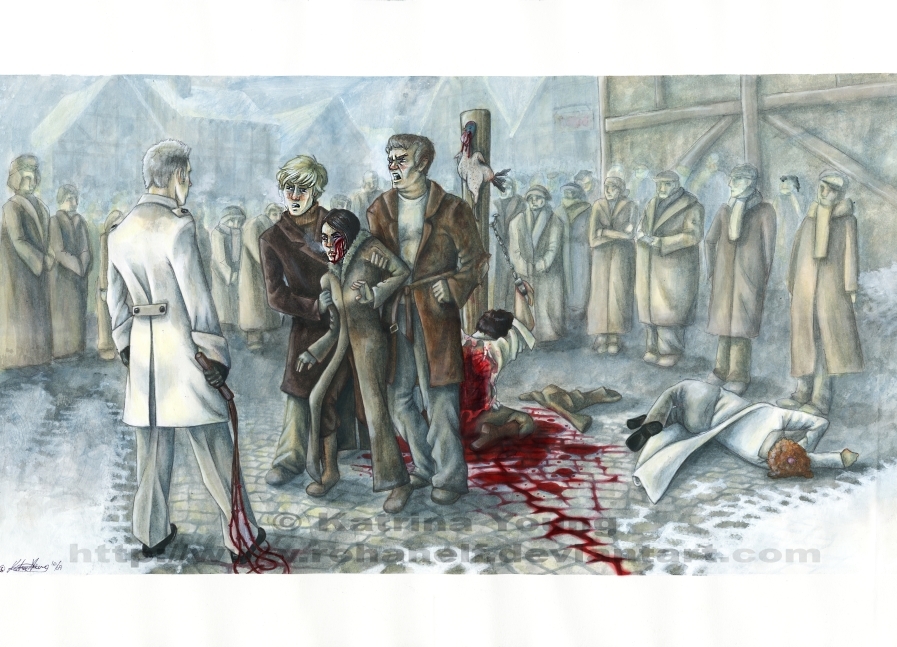 |
| source |
In light of the first teaser trailer of Mockingjay Part 1 released just last week, I'd like to turn to literary alchemy once again. Because once you know the symbols and images that correlate to alchemy, it's near impossible not to feel as if the trailer is wrought with alchemical meaning. John gives a lengthy but extremely readable discussion of literary alchemy and how Suzanne Collins particularly, uses it to structure her Hunger Games series here. I recommend reading through it at least once, but here is a short snippet that very simply describes the process of alchemical literature:
"Alchemy is a three stage work in its simplest outline...with each stage represented traditionally by a different color and set of meaningful images. In the first, the person to be enlightened is broken down, shattered really, to their core idea or ‘prime matter.’ This process when represented in metallurgy was one of “burning down” and was known as the nigredo or black stage because of this process. The second stage is one of purification or cleansing. The shattered survivor of the nigredo here is washed and restored in preparation for the chrysalis of the remaining stage. Unlike the first stage, then, which was represented by the color black and fire, the second stage, the albedo, that is the opposite of the first, is about the color white and purifying water. The last stage is red because the person’s transformation and illumination accomplished in the albedo is revealed usually in the red-hot crucible of the story’s final crisis. It is is called the rubedo and as you’ve probably guessed is represented by red figures."
So it is in a series of three stages then, that the hero of an alchemical work--like the alchemist and his base metal itself-- is transformed metaphorically from lead into gold. John argues that each of the three books of the Hunger Games series relates to a stage; the first stage is played out in The Hunger Games, the second in Catching Fire, and the third, of course, in Mockingjay.
 |
| source |
There's no doubt that The Hunger Games thrusts us right into the Nigredo stage. This first stage, which is often marked with a world-shattering moment and flooded with imagery of darkness and the color black, dominates the opening chapters of The Hunger Games. For instance, before we really even know anything about Katniss herself, we're given details of the dark and bleak community she grew up in: the coal mining District 12, where men and women "have long since stopped trying to scrub the coal dust out of their broken nails"(4) and which is filled with "black cinder streets" (4) and "squat grey houses" (4). Likewise Katniss' entire world is shattered once she hears Prim's name called out at the reaping:
"It was as if the impact had knocked every wisp of air from my lungs, and I lay there struggling to inhale, to exhale, to do anything. That's how I feel now, trying to remember how to breathe, unable to speak, totally stunned as the name bounces inside of my skull" (21).
 |
| Art by Sam Spratt |
The second stage of the alchemical process, the cleansing albedo stage, is immediately made clear in Catching Fire. Now that Katniss has been broken down to her base material (John call's this her "core identity: sacrificial lover of Peeta"), the second novel in the series is all about Katniss being purified and cleansed. Images of this stage-- water, silver, the moon, whiteness-- permeate throughout Catching Fire. As the novel opens, for instance, we see the black streets of District 12 made white with snow. The light snow that starts to fall in the opening pages of the novel turns wet and heavy and it sticks throughout Katniss' time there: "My eyes peer through the trees, past the fence, into the Meadow. All I can see is the wet snow illuminated here and there by the light from the windows on the edge of the Seam" (152). Also, time and time again, we see snow and water not only as images of cleansing, but as healing agents and lifesavers. John Granger states,
"Snow is a perfect token of the white stage because it is both water and white. To drive home the 'purification' symbolism of this stage of Katniss’ transformation, the arena has water at its center, the most deadly of its challenges is a nerve gas that attacks in a cloud of white mist, and the cure for its effects are washing in water" (once again, from Unlocking Mockingjay).
 |
| source |
Even before Katniss returns to the Arena, we are shown the healing powers of water and snow. For Katniss' mother, a healer, relies on snow to help the injured. Before giving Gale more medicine after he's been whipped, for instance, she uses snow instead:
"Prim comes over, stirring what appears to be a large bowl of snow. But it’s tinted a light green and gives off a sweet, clean scent. Snow coat. She carefully begins to ladle the stuff onto the cloth. I can almost hear the sizzle of Gale’s tormented skin meeting the snow mixture. His eyes flutter open, perplexed, and then he lets out a sound of relief " (124).Katniss, too, feels the healing effects of snow firsthand: "I hold it to the weal on my cheek. Instantly the pain withdraws" (125).
And once in the arena, there is not only water at the "clock's" center and harmful white mist that is healed with water, but water that continually saves Katniss and Peeta. The moment she receives the life saving (and silver) spile (that's delivered in a silver parachute [292]) is bathed in imagery of both moonlight and water: "I wipe the sweat from my eyes and hold the gift out in the moonlight. I move it this way and that, viewing it from different angles, covering portions and then revealing them. Trying to make it divulge its purpose to me….We fill the basket and pass it around, taking deep gulps and, later, luxuriously, splashing our faces clean " (293). Water cleanses and heals them throughout Catching Fire and is a constant symbol of Katniss' albedo stage.
The third stage, seen in the final book in the series, Mockingjay, is the golden-red Rubedo stage. Katniss has been broken down to her "base material" and has been washed and purified; she is ready to be perfected, to be transformed into gold. Unsurprisingly, this final stage of the alchemical work is signified by splendrous light and by red and golden colors. Here the phoenix imagery that pervades throughout the series is brought on full force. Since the first book, Katniss has been the "Girl on Fire", but it isn't until the third and final book where the metaphor becomes literal. Fire--real fire-- is everywhere in Mockingjay.
“ 'President Snow says he’s sending us a message? Well, I have one for him. You can torture us and bomb us and burn our districts to the ground, but do you see that?' One of the cameras follows as I point to the planes burning on the roof of the warehouse across from us. The Capitol seal on a wing glows clearly through the flames. 'Fire is catching!' I am shouting now, determined that he will not miss a word. 'And if we burn, you burn with us!' " (97-98).As the rebellion wages on, fire becomes more than just a dress and more than a symbol. It literarily destroys. And yet, fire in Mockingjay destroys to in order to help heal. Collins uses red imagery and fire to illustrate Katniss's ultimate alchemical transformation and rebirth from warrior, fighter, and leader to lover, nurturer, and mother. And in the book's final pages Collins uses two contrasting golden images to illustrate Katniss's turn away from bloodshed and anger towards peace and unity:
 |
| source |
"...what I need to survive is not Gale’s fire, kindled with rage and hatred. I have plenty of fire myself. What I need is the dandelion in the spring. The bright yellow that means rebirth instead of destruction. The promise that life can go on, no matter how bad our losses. That it can be good again. And only Peeta can give me that" (386).
This only briefly outlines what one can find in the Hunger Games trilogy if we look through the lens of literary alchemy. What's so very interesting in the latest teaser trailer for the movie Mockingjay Part One, however, is that we don't have to look very hard at all. The trailer is doused in white, white, white and it begs, I think, for a comparison of Peeta and President Snow as albedo figures, something I'll explore in the second part of this post in the upcoming days...

You told nicely As the rebellion wages on, fire becomes more than just a dress and more than a symbol. It literally destroys.Thanks.
ReplyDeleteSecond time reading! Love this! Wish the movie was more like the book! Still like both, and will read the other books again as well.
ReplyDelete